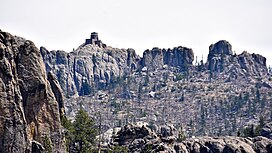
Back جبل بلاك الك پياك ARZ Блэк-Элк Byelorussian Harney Peak CEB Black Elk Peak German Pic Black Elk French Black Elk Peak FRR Black Elk Peak LLD Black Elk Peak NB Harney Peak Polish ٹلہ ہارنی PNB
| Black Elk Peak | |
|---|---|
 Black Elk Peak, the highest point in South Dakota viewed from Black Elk Peak Trail, May 2018. | |
| Highest point | |
| Elevation | 7,244 ft (2,208 m) NAVD 88[1][2] |
| Prominence | 2,922 ft (891 m)[3] |
| Listing | |
| Coordinates | 43°51′57″N 103°31′57″W / 43.865847725°N 103.532431997°W[1] |
| Geography | |
| Country | United States |
| State | South Dakota |
| County | Pennington County |
| Parent range | Black Hills |
| Topo map | USGS Custer |
| Climbing | |
| First ascent | July 24, 1875 by Valentine McGillycuddy and party[4][5] |
| Easiest route | hike, Trail 9[6] |
  |
| Southwestern South Dakota |
|---|
| Sculptures |
| Geologic and natural history |
| Mountains |
| Caves |
| Forests and wildernesses |
| Lakes |
| Scenic byways |
| Historic sites |
Black Elk Peak, formerly known as Harney Peak, is the highest natural point in the U.S. state of South Dakota and the Midwestern United States. It lies in the Black Elk Wilderness area, in southern Pennington County, in the Black Hills National Forest.[3] The peak lies 3.7 mi (6.0 km) west-southwest of Mount Rushmore.[7] At 7,244 feet (2,208 m),[1] it is the highest summit in the United States east of the Rocky Mountains. Though part of the North American Cordillera, it is generally considered to be geologically separate from the Rocky Mountains.
It is also known as Hiŋháŋ Káǧa ('owl-maker' in Lakota) and Heȟáka Sápa ('elk black').
The U.S. Board on Geographic Names, which has jurisdiction in federal lands, officially changed the mountain's name from Harney Peak to Black Elk Peak on August 11, 2016, honoring Black Elk, the noted Lakota Sioux medicine man and Catholic Servant of God for whom the Wilderness Area is named.[8]
In September 2016, a team of professional surveyors obtained precise GNSS data over the course of two days and found the highest natural rock to be at 7,231.32 feet (2,204.11 m) NAVD88 and a nearby secondary peak located approximately 300 feet south of the lookout tower and unofficially named "McGillicuddy's Peak", to be slightly lower at 7,229.41 feet (2,203.52 m) NAVD88. This is believed to be the only precise survey that has been made to determine the true elevation of this peak.[9][10]
The peak's fire lookout tower and the staircase leading to it, as well as a nearby dam and pumphouse, were listed on the National Register of Historic Places in 1983.[11]
- ^ a b c "Harney". NGS Data Sheet. National Geodetic Survey, National Oceanic and Atmospheric Administration, United States Department of Commerce. Retrieved 2008-11-08.
- ^ "Topographic map of Black Elk Peak". opentopomap.org. Retrieved 2023-05-06.
- ^ a b "Black Elk Peak, South Dakota". Peakbagger.com. Retrieved 2008-12-29.
- ^ McGillycuddy and party had the first recorded ascent, though sources call him the first non-native or the first white man to climb the mountain. See Cerney, Jan; Sago, Roberta (2011). Black Hills National Forest: Harney Peak and the Historic Fire Lookout Towers. Arcadia. ISBN 978-1439625729. and "At the Highest Point". Black Hills Visitor. 2017-08-25. Retrieved 2019-08-15..
- ^ James R. Macdonald, Ph.D. (2009). "Museum of Geology: History". Rapid City, South Dakota: South Dakota School of Mines & Technology. Retrieved 2012-11-10.
- ^ Cite error: The named reference
trailheadswas invoked but never defined (see the help page). - ^ Mount Rushmore, South Dakota, 30x60 Minute Topographic Quadrangle, USGS, 1977
- ^ Cite error: The named reference
blackelkwas invoked but never defined (see the help page). - ^ Penry, Jerry. "Harney Peak's Elevation". Retrieved 2016-12-19.
- ^ Tupper, Seth (2016-12-26). "How South Dakota's high point ended up shorter than thought". Rapid City Journal. Retrieved 2016-12-26.
- ^ Cite error: The named reference
nriswas invoked but never defined (see the help page).
© MMXXIII Rich X Search. We shall prevail. All rights reserved. Rich X Search

